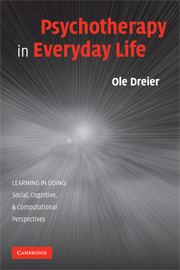Book contents
- Frontmatter
- Contents
- Series Foreword
- Preface
- Introduction
- 1 Re-Searching Psychotherapy as a Social Practice
- 2 Theorizing Persons in Structures of Social Practice
- 3 A Study – Its Design and Conduct
- 4 Clients' Ordinary Lives Plus Sessions
- 5 Therapy in Clients' Social Practice across Places
- 6 Changes in Clients' Practice across Places
- 7 Changing Problems across Places
- 8 The Conduct of Everyday Life and the Life Trajectory
- 9 The Children's Changing Conducts of Everyday Life and Life Trajectories
- 10 The Parents' Changing Conducts of Everyday Life and Life Trajectories
- 11 The Changing Conduct of Everyday Family Life and Family Trajectory
- 12 Research in Social Practice
- References
- Author Index
- Subject Index
- Learning in Doing: Social, Cognitive, and Computational Perspectives
7 - Changing Problems across Places
Published online by Cambridge University Press: 15 December 2009
- Frontmatter
- Contents
- Series Foreword
- Preface
- Introduction
- 1 Re-Searching Psychotherapy as a Social Practice
- 2 Theorizing Persons in Structures of Social Practice
- 3 A Study – Its Design and Conduct
- 4 Clients' Ordinary Lives Plus Sessions
- 5 Therapy in Clients' Social Practice across Places
- 6 Changes in Clients' Practice across Places
- 7 Changing Problems across Places
- 8 The Conduct of Everyday Life and the Life Trajectory
- 9 The Children's Changing Conducts of Everyday Life and Life Trajectories
- 10 The Parents' Changing Conducts of Everyday Life and Life Trajectories
- 11 The Changing Conduct of Everyday Family Life and Family Trajectory
- 12 Research in Social Practice
- References
- Author Index
- Subject Index
- Learning in Doing: Social, Cognitive, and Computational Perspectives
Summary
Focus and Frame
In this chapter, I analyze client changes in relation to problems. It includes how clients' understandings and relations to their problems change and how changes in their problems are brought about.
First, I shall frame my analysis of changing problems in general terms. In section 4.3, I stressed the clients' tendency at first to view the troubles for which they seek therapy as peculiar mental states and properties in the referred patient Angie. They see these mental states and properties as external causes for the troubles they encounter in their ongoing social practice in the sense that these causes are seen as independent of their social practice and as intruding into it. To put it differently, it is incomprehensible to them how these mental states and properties are parts of their and Angie's ongoing social practice. I shall analyze these problems as dark sides of their social practice, that is, as obscure and troublesome parts of it, and point out how the clients gradually come to recognize their problems as they change their ways of dealing with them and understanding them. In my approach, problems are not given or resolved states; they are instead changing parts of their changing social practice with changing properties, meanings, and links in their ongoing practice. Therefore, chapter 6 frames my analysis of their problems.
- Type
- Chapter
- Information
- Psychotherapy in Everyday Life , pp. 141 - 180Publisher: Cambridge University PressPrint publication year: 2007



